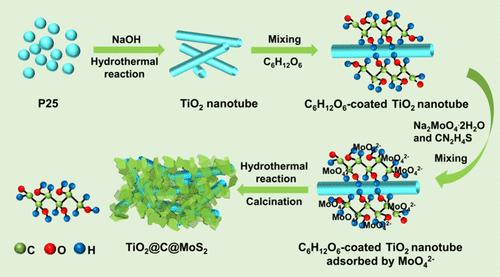桥接 TiO2 纳米管和 MoS2 纳米片的多功能碳层可增强锂存储能力
IF 5.3
2区 材料科学
Q2 MATERIALS SCIENCE, MULTIDISCIPLINARY
引用次数: 0
摘要
本文巧妙地采用葡萄糖辅助水热法,用多功能碳层(C)桥接TiO2纳米管和MoS2纳米片,合成了三维(3D)TiO2@C@MoS2复合材料。多功能碳层通过产生 C-S 和 Ti-O-C 化学键将 MoS2 纳米片和 TiO2 纳米管连接起来,不仅降低了复合材料在充放电循环过程中的机械应力,增强了复合材料的结构稳定性,还提高了复合材料的整体导电性。此外,一维(1D)TiO2 纳米管为 MoS2 纳米片的生长提供了可靠的骨架,有效缩短了离子/电子的传输路径。表面的 MoS2 纳米片有助于增加电化学反应的活性位点,从而加快材料内部的电荷转移。因此,复合材料的整体电化学性能得到了改善。制备的 TiO2@C@MoS2 复合材料显示出高达 881.77 mAh g-1 的初始放电比容量,即使在 0.2 A g-1 的条件下循环 200 次,容量保持率仍高达 81%。出色的比容量和令人印象深刻的循环稳定性归功于桥接 TiO2 纳米管和 MoS2 纳米片的多功能碳层的独特协同效应。该制备方法为合成其他复合材料提供了前景,拓宽了锂离子电池负极研究的视野。本文章由计算机程序翻译,如有差异,请以英文原文为准。

Multifunctional Carbon Layer Bridging TiO2 Nanotubes and MoS2 Nanosheets for Enhanced Lithium Storage
This article ingeniously adopts a glucose-assisted hydrothermal method to bridge TiO2 nanotubes and MoS2 nanosheets with a multifunctional carbon layer (C), synthesizing three-dimensional (3D) TiO2@C@MoS2 composites. The multifunctional carbon layer bridges MoS2 nanosheets and TiO2 nanotubes by creating C–S and Ti–O–C chemical bonds, which not only reduces the mechanical stress of the composites during charge/discharge cycling and enhances the structural stability of the composites but also improves the overall conductivity of the composites. Furthermore, the one-dimensional (1D) TiO2 nanotubes act as a reliable skeleton for the growth of MoS2 nanosheets, effectively shortening the transport path for ions/electrons. The MoS2 nanosheets on the surface contribute to an increase in active sites for electrochemical reactions, thus bringing about faster charge transfer within the material. As a result, the overall electrochemical properties of the composites are improved. The prepared TiO2@C@MoS2 composites show up to an initial discharge specific capacity of 881.77 mAh g–1, sustaining a capacity retention of 81% even after 200 cycles at 0.2 A g–1. The outstanding specific capacity and impressive cyclic stability are ascribed to the unique synergistic effect of the multifunctional carbon layer bridging TiO2 nanotubes and MoS2 nanosheets. This preparation offers a perspective for the synthesis of other composite materials, broadening the horizons of lithium-ion battery anode research.
求助全文
通过发布文献求助,成功后即可免费获取论文全文。
去求助
来源期刊

ACS Applied Nano Materials
Multiple-
CiteScore
8.30
自引率
3.40%
发文量
1601
期刊介绍:
ACS Applied Nano Materials is an interdisciplinary journal publishing original research covering all aspects of engineering, chemistry, physics and biology relevant to applications of nanomaterials. The journal is devoted to reports of new and original experimental and theoretical research of an applied nature that integrate knowledge in the areas of materials, engineering, physics, bioscience, and chemistry into important applications of nanomaterials.
 求助内容:
求助内容: 应助结果提醒方式:
应助结果提醒方式:


